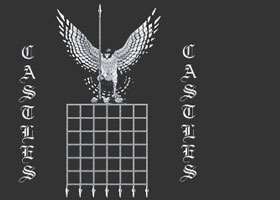Medieval SwordsMedieval Swords - Facts and information about the history of Medieval Swords and their parts
- Facts, Information and History
- Medieval Swords - The Broadsword, Greatsword, Bastardsword, Falchion, Cutting sword and Baton
History of Types of Medieval Swords
Facts and information about the history and different types of Medieval swords are detailed in the following descriptions: - The Broadsword - The earliest of the Medieval swords from the 6th Century. The Broadsword had a two-edged blade measuring 2-3 inches wide at the base and tapering to a point. The length of the Broadsword ranged from 30 - 45 inches and weighed between 3 - 5 pounds
- The Falchion - A Falchion was favoured by some Medieval Knights who had been on Crusade. This sword was similar to a heavy scimitar. The Falchion sword had a short, heavy blade with a single edge
- The Greatsword - The Greatsword was was used in Scotland and also referred to as the Claymore. The Greatswords were large two-handed swords. The length of the Greatsword ranged from from 50 to 72 inches, with a handle that measured 18 - 21 inches in additional length. Greatswords weighed between
6 - 10 pounds - The Bastardsword (Longsword) - Bastardswords are also known as Hand and a Half swords and Longswords. The length of the Bastardsword ranged from from 44 to 50 inches in length. The Greatsword featured an extended handle that allowed the blade to be used in two hands
- The Cutting sword - These swords were at first used by early Medieval Knights and were also particularly favoured by the the Vikings. A slashing stroke would be used but this became ineffective against heavy body armour
- The Baton - Batons, or Behourds, were the names of the swords which were used in Tournaments and were made of whalebone. A Rebated sword is one that has had its point and edge blunted for training or tournament.
The different types of Medieval swords ranged from the smallest Broadsword measuring from 30 inches to the Greatswords which measured up to 72 inches. The weight of Medieval swords are usually presumed to be a lot heavier than they actually were! Training to use Medieval Swords
Skill in using Medieval weapons, including swords, were necessary for every Medieval Knight. A Knight was trained first as a Page from the age of 7 to 14 and then as Squire from the age of 14 to 21. A Knight was therefore usually the age of 21 before would make a formal entry into Knighthood. It was the duty of a Knight to learn how to fight, become accomplished at using the sword as his primary weapon, and so serve their Lord according to the Code of Chivalry. Almost 14 years of training enabled the knight use the sword with considerable strength and skill. The Parts of Medieval Swords
Facts and information about the history and different parts of swords of the Middle Ages are detailed in the following descriptions: - The Blade - The blades of Medieval swords which were used in England were usually straight with two sharpened edges. The history of Blades shows that they were first made of Bronze, then iron and culminating in the steel Medieval swords
- The Crossguard or Quillion - This was the handle of the sword resembling the shape of the Christian cross. Expensive to produce and sometimes covered in precious metals - bronze, silver or gold
- The Edge - The cutting part of the blade. Swords were designed to be used for blows directly against the opponent's body or shield and in the edge to edge style of sword fighting
- The Forte - The strongest part of the swords blade, nearest the hilt
- The Fuller - The central shallow on a straight double edged blade - also referred to as the 'Blood Gutter'!
- The Grip - The hilt of swords held in the hand of the Knight. The Grip was often made of horn or wood, covered in leather and contoured to fit in the hand
- The Hilt - The Hilt is the handle of the sword made up of the crossguard, grip and the pommel. The personal engravings on the hilt, and its expense, would often ensure that when a blade was disguarded the hilt would be re-used
- The Pommel -The pommel was part of the hilt which acted as a counterweight to the blade on Medieval swords
- The Tang - The tang was the unsharpened end of the sword blade covered by the hilt
Medieval Swords
Facts and information about the history and different types of Medieval swords and parts. |

